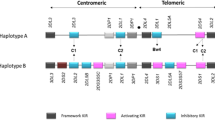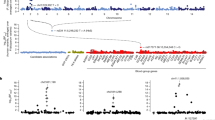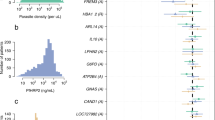Abstract
A genome-wide scan was conducted for the levels of total immunoglobulin G (IgG) and IgG subclasses directed against Plasmodium falciparum antigens in an urban population living in Burkina Faso. Non-parametric multipoint linkage analysis provided three chromosomal regions with genome-wide significant evidence (logarithm of the odds (LOD) score >3.6), and five chromosomal regions with genome-wide suggestive evidence (LOD score >2.2). IgG3 levels were significantly linked to chromosomes 8p22-p21 and 20q13, whereas IgG4 levels were significantly linked to chromosome 9q34. In addition, we detected suggestive linkage of IgG1 levels to chromosomes 18p11-q12 and 18q12-q21, IgG4 levels to chromosomes 1p31 and 12q24 and IgG levels to chromosome 6p24-p21. Moreover, we genotyped genetic markers located within the regions of interest in a rural population living in Burkina Faso. We detected genome-wide significant and suggestive linkage results when combining the two study populations for chromosomes 1p31, 6p24-p21, 8p22-p21, 9q34, 12q24 and 20q13. Because high anti-parasite IgG3 and low anti-parasite IgG4 levels were associated with malaria resistance, the chromosomal regions linked to IgG3 and IgG4 levels are of special interest. Although the results should be confirmed in an independent population, they may provide new insights in understanding both the genetic control of IgG production and malaria resistance.
This is a preview of subscription content, access via your institution
Access options
Subscribe to this journal
Receive 6 digital issues and online access to articles
$119.00 per year
only $19.83 per issue
Buy this article
- Purchase on Springer Link
- Instant access to full article PDF
Prices may be subject to local taxes which are calculated during checkout




Similar content being viewed by others
References
Kwiatkowski DP . How malaria has affected the human genome and what human genetics can teach us about malaria. Am J Hum Genet 2005; 77: 171–192.
Brisebarre A, Kumulungui B, Sawadogo S, Atkinson A, Garnier S, Fumoux F et al. A genome scan for Plasmodium falciparum malaria identifies quantitative trait loci on chromosomes 5q31, 6p21.3, 17p12, and 19p13. Malar J 2014; 13: 198.
Milet J, Nuel G, Watier L, Courtin D, Slaoui Y, Senghor P et al. Genome wide linkage study, using a 250K SNP map, of Plasmodium falciparum infection and mild malaria attack in a Senegalese population. PLoS ONE 2010; 5: e11616.
Sakuntabhai A, Ndiaye R, Casademont I, Peerapittayamongkol C, Rogier C, Tortevoye P et al. Genetic determination and linkage mapping of Plasmodium falciparum malaria related traits in Senegal. PLoS ONE 2008; 3: e2000.
Marsh K, Kinyanjui S . Immune effector mechanisms in malaria. Parasite Immunol 2006; 28: 51–60.
Jepson A, Banya W, Sisay-Joof F, Hassan-King M, Nunes C, Bennett S et al. Quantification of the relative contribution of major histocompatibility complex (MHC) and non-MHC genes to human immune responses to foreign antigens. Infect Immun 1997; 65: 872–876.
Bouharoun-Tayoun H, Attanath P, Sabchareon A, Chongsuphajaisiddhi T, Druilhe P . Antibodies that protect humans against Plasmodium falciparum blood stages do not on their own inhibit parasite growth and invasion in vitro, but act in cooperation with monocytes. J Exp Med 1990; 172: 1633–1641.
Bouharoun-Tayoun H, Druilhe P . Antibodies in falciparum malaria: what matters most, quantity or quality? Mem Inst Oswaldo Cruz 1992; 87: 229–234.
Segeja MD, Mmbando BP, Seth MD, Lusingu JP, Lemnge MM . Acquisition of antibodies to merozoite surface protein 3 among residents of Korogwe, north eastern Tanzania. BMC Infect Dis 2010; 10: 55.
Stanisic DI, Richards JS, McCallum FJ, Michon P, King CL, Schoepflin S et al. Immunoglobulin G subclass-specific responses against Plasmodium falciparum merozoite antigens are associated with control of parasitemia and protection from symptomatic illness. Infect Immun 2009; 77: 1165–1174.
Balogun HA, Awah N, Nilsson S, Rogier C, Trape JF, Chen Q et al. Pattern of antibodies to the Duffy binding like domain of Plasmodium falciparum antigen Pf332 in Senegalese individuals. Acta Trop 2013; 130C: 80–87.
Aucan C, Traore Y, Tall F, Nacro B, Traore-Leroux T, Fumoux F et al. High immunoglobulin G2 (IgG2) and low IgG4 levels are associated with human resistance to Plasmodium falciparum malaria. Infect Immun 2000; 68: 1252–1258.
Nasr A, Iriemenam NC, Giha HA, Balogun HA, Anders RF, Troye-Blomberg M et al. FcgammaRIIa (CD32) polymorphism and anti-malarial IgG subclass pattern among Fulani and sympatric ethnic groups living in eastern Sudan. Malar J 2009; 8: 43.
Aucan C, Traore Y, Fumoux F, Rihet P . Familial correlation of immunoglobulin G subclass responses to Plasmodium falciparum antigens in Burkina Faso. Infect Immun 2001; 69: 996–1001.
Stirnadel HA, Beck HP, Alpers MP, Smith TA . Genetic analysis of IgG subclass responses against RESA and MSP2 of Plasmodium falciparum in adults in Papua New Guinea. Epidemiol Infect 2000; 124: 153–162.
Afridi S, Atkinson A, Garnier S, Fumoux F, Rihet P . Malaria resistance genes are associated with the levels of IgG subclasses directed against Plasmodium falciparum blood-stage antigens in Burkina Faso. Malar J 2012; 11: 308.
Carpenter D, Abushama H, Bereczky S, Farnert A, Rooth I, Troye-Blomberg M et al. Immunogenetic control of antibody responsiveness in a malaria endemic area. Hum Immunol 2007; 68: 165–169.
Ntoumi F, Flori L, Mayengue PI, Matondo Maya DW, Issifou S, Deloron P et al. Influence of carriage of hemoglobin AS and the Fc gamma receptor IIa-R131 allele on levels of immunoglobulin G2 antibodies to Plasmodium falciparum merozoite antigens in Gabonese children. J Infect Dis 2005; 192: 1975–1980.
Sabbagh A, Courtin D, Milet J, Massaro JD, Castelli EC, Migot-Nabias F et al. Association of HLA-G 3' untranslated region polymorphisms with antibody response against Plasmodium falciparum antigens: preliminary results. Tissue Antigens 2013; 82: 53–58.
Sarr JB, Pelleau S, Toly C, Guitard J, Konate L, Deloron P et al. Impact of red blood cell polymorphisms on the antibody response to Plasmodium falciparum in Senegal. Microbes Infect 2006; 8: 1260–1268.
Tangteerawatana P, Perlmann H, Hayano M, Kalambaheti T, Troye-Blomberg M, Khusmith S . IL4 gene polymorphism and previous malaria experiences manipulate anti-Plasmodium falciparum antibody isotype profiles in complicated and uncomplicated malaria. Malar J 2009; 8: 286.
Flori L, Sawadogo S, Esnault C, Delahaye NF, Fumoux F, Rihet P . Linkage of mild malaria to the major histocompatibility complex in families living in Burkina Faso. Hum Mol Genet 2003; 12: 375–378.
Migot-Nabias F, Mombo LE, Luty AJ, Dubois B, Nabias R, Bisseye C et al. Human genetic factors related to susceptibility to mild malaria in Gabon. Genes Immun 2000; 1: 435–441.
Timmann C, Thye T, Vens M, Evans J, May J, Ehmen C et al. Genome-wide association study indicates two novel resistance loci for severe malaria. Nature 2012; 489: 443–446.
Barbier M, Atkinson A, Fumoux F, Rihet P . IL12B polymorphisms are linked but not associated with Plasmodium falciparum parasitemia: a familial study in Burkina Faso. Genes Immun 2008; 9: 405–411.
Flori L, Kumulungui B, Aucan C, Esnault C, Traore AS, Fumoux F et al. Linkage and association between Plasmodium falciparum blood infection levels and chromosome 5q31-q33. Genes Immun 2003; 4: 265–268.
Naka I, Nishida N, Patarapotikul J, Nuchnoi P, Tokunaga K, Hananantachai H et al. Identification of a haplotype block in the 5q31 cytokine gene cluster associated with the susceptibility to severe malaria. Malar J 2009; 8: 232.
Rihet P, Traore Y, Abel L, Aucan C, Traore-Leroux T, Fumoux F . Malaria in humans: Plasmodium falciparum blood infection levels are linked to chromosome 5q31-q33. Am J Hum Genet 1998; 63: 498–505.
Boussiotis VA, Nadler LM, Strominger JL, Goldfeld AE . Tumor necrosis factor alpha is an autocrine growth factor for normal human B cells. Proc Natl Acad Sci USA 1994; 91: 7007–7011.
Rihet P, Abel L, Traore Y, Traore-Leroux T, Aucan C, Fumoux F . Human malaria: segregation analysis of blood infection levels in a suburban area and a rural area in Burkina Faso. Genet Epidemiol 1998; 15: 435–450.
O'Connell JR, Weeks DE . PedCheck: a program for identification of genotype incompatibilities in linkage analysis. Am J Hum Genet 1998; 63: 259–266.
Abecasis GR, Cherny SS, Cookson WO, Cardon LR . Merlin—rapid analysis of dense genetic maps using sparse gene flow trees. Nat Genet 2002; 30: 97–101.
Sham PC, Purcell S, Cherny SS, Abecasis GR . Powerful regression-based quantitative-trait linkage analysis of general pedigrees. Am J Hum Genet 20; 71: 238–253.
Acknowledgements
This work was supported by grants from the Centre National de Genotypage, the French Ministry of Research and Technology, and Institut National de la Santé et de la Recherche Médicale (Inserm). AB and SA were supported by a PhD fellowship from the French Ministry of Research and Technology and a PhD fellowship from the Higher Education Commission (HEC) from Pakistan, respectively. We thank all the individuals for participating in the study. We also thank the Centre National de Genotypage for providing access to their genotyping facilities.
Author information
Authors and Affiliations
Corresponding author
Ethics declarations
Competing interests
The authors declare no conflict of interest.
Additional information
Supplementary Information accompanies this paper on Genes and Immunity website
Rights and permissions
About this article
Cite this article
Brisebarre, A., Kumulungui, B., Sawadogo, S. et al. Genome-wide significant linkage to IgG subclass responses against Plasmodium falciparum antigens on chromosomes 8p22-p21, 9q34 and 20q13. Genes Immun 16, 187–192 (2015). https://doi.org/10.1038/gene.2014.66
Received:
Revised:
Accepted:
Published:
Issue Date:
DOI: https://doi.org/10.1038/gene.2014.66
This article is cited by
-
Genome-wide association study of antibody responses to Plasmodium falciparum candidate vaccine antigens
Genes & Immunity (2016)
-
Genetic determinants of anti-malarial acquired immunity in a large multi-centre study
Malaria Journal (2015)



